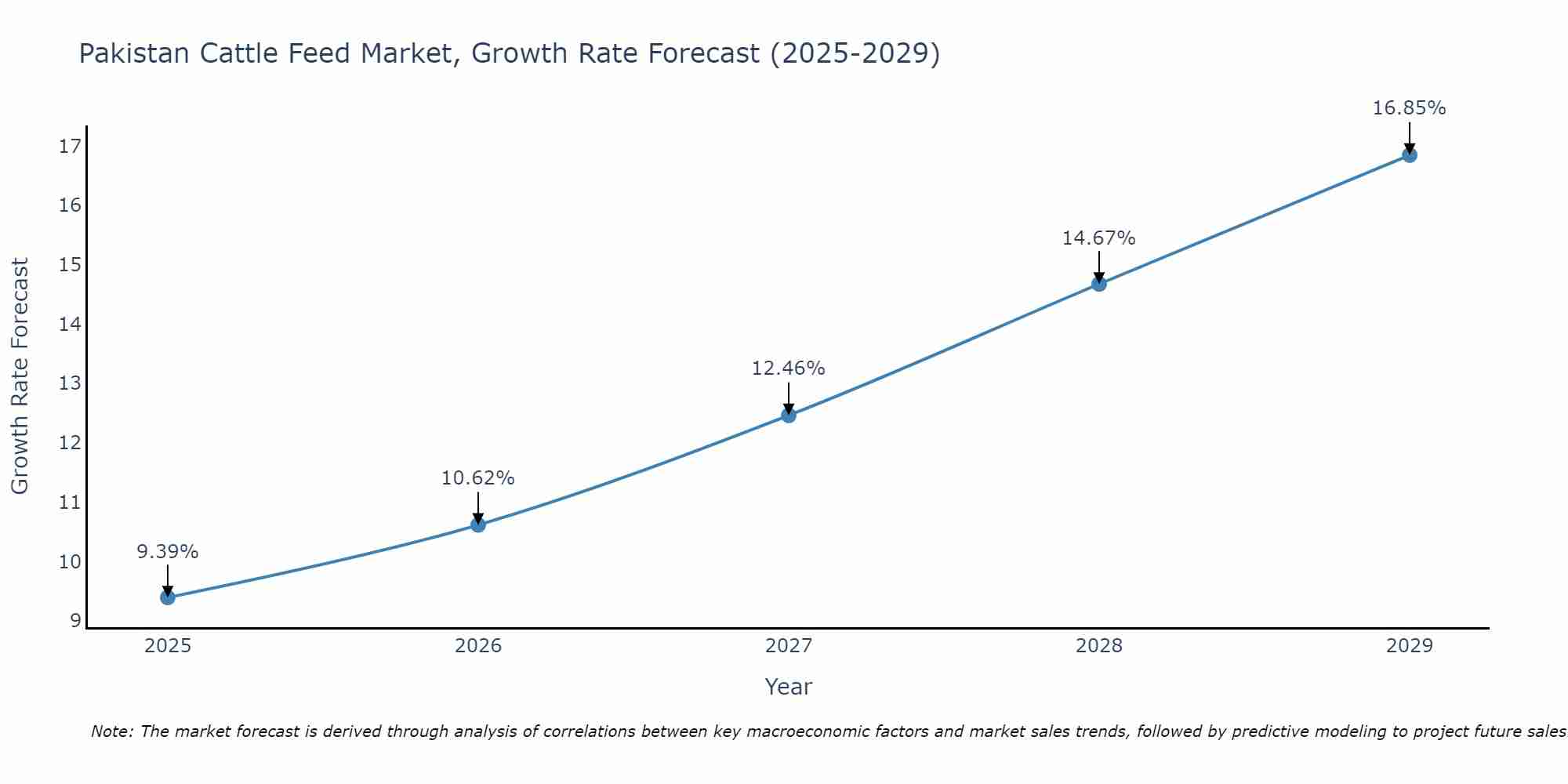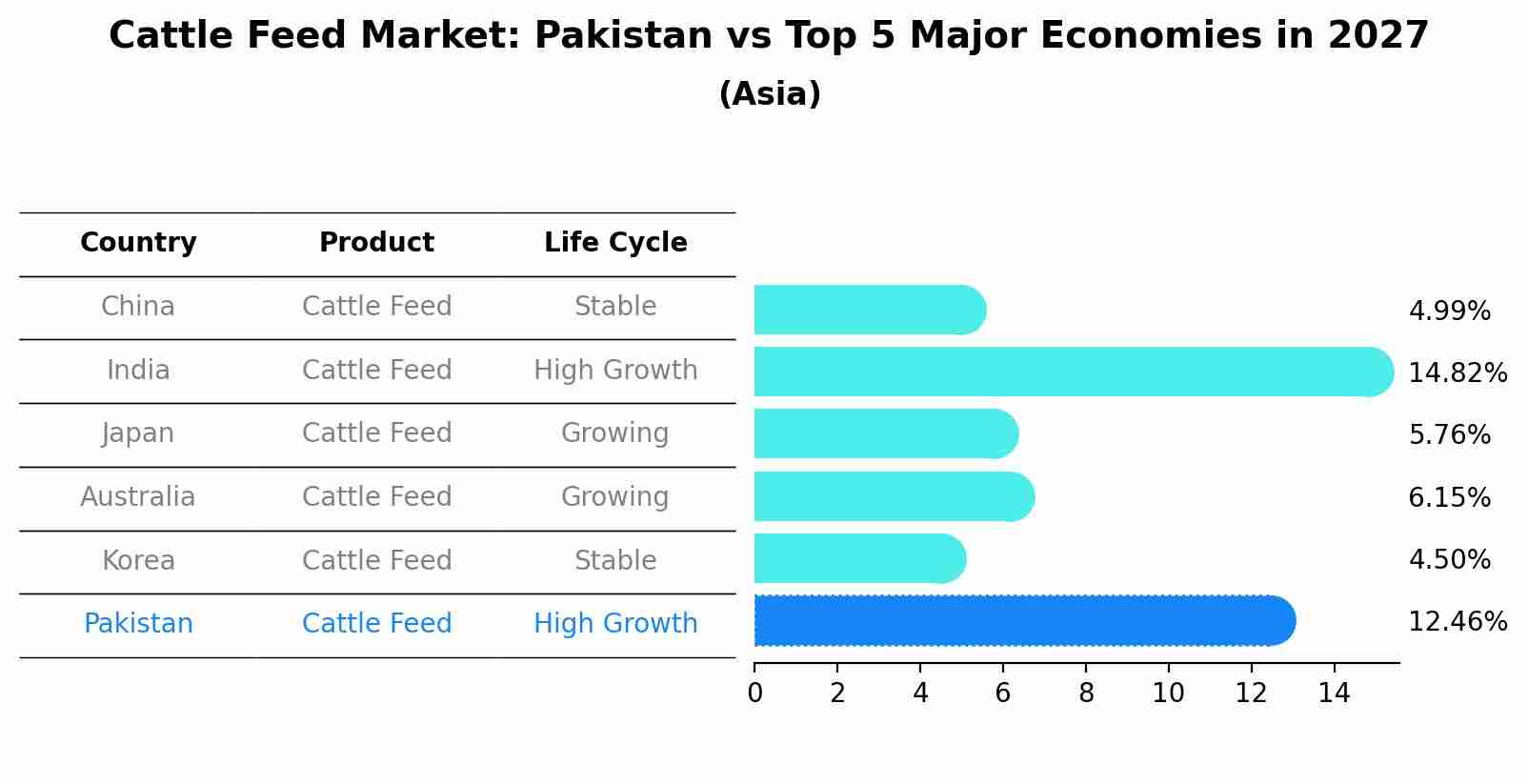Pakistan Cattle Feed Market Outlook | COVID-19 IMPACT, Analysis, Trends, Industry, Forecast, Share, Value, Companies, Revenue, Size & Growth
| Product Code: ETC380797 | Publication Date: Aug 2022 | Updated Date: Apr 2025 | Product Type: Market Research Report | |
| Publisher: 6Wresearch | Author: Shubham Padhi | No. of Pages: 75 | No. of Figures: 35 | No. of Tables: 20 |
Pakistan Cattle Feed Market Size Growth Rate
The Pakistan Cattle Feed Market is likely to experience consistent growth rate gains over the period 2025 to 2029. Commencing at 9.39% in 2025, growth builds up to 16.85% by 2029.

Cattle Feed Market: Pakistan vs Top 5 Major Economies in 2027 (Asia)
By 2027, Pakistan's Cattle Feed market is forecasted to achieve a high growth rate of 12.46%, with China leading the Asia region, followed by India, Japan, Australia and South Korea.

Pakistan Cattle Feed Market Overview
The cattle feed market in Pakistan is expanding, reflecting the country`s significant livestock sector. Cattle feed includes various nutritional products designed to enhance the health and productivity of livestock. The market is driven by the need for efficient and sustainable animal husbandry practices, increasing milk and meat production, and government initiatives to support the livestock industry. Innovations in feed formulations and the growing awareness of the benefits of balanced nutrition are further propelling market growth.
Drivers of the market
The growing livestock industry and the increasing demand for high-quality animal protein are driving the cattle feed market in Pakistan. Farmers are adopting nutritionally balanced and fortified cattle feed to improve livestock health and productivity. The government`s support for the agriculture and livestock sectors is also contributing to market growth.
Challenges of the market
The cattle feed market in Pakistan faces challenges related to price volatility and the availability of high-quality raw materials. Agricultural productivity and supply chain inefficiencies also impact market stability and growth.
Government Policy of the market
The Pakistani government recognizes the critical role of the livestock sector in the national economy and implements policies to support the cattle feed market. These policies focus on promoting research and development in animal nutrition to improve the quality and efficiency of cattle feed formulations. Regulatory frameworks ensure product safety, quality standards, and nutritional content in cattle feed production. Government incentives such as subsidies, tax breaks, and credit facilities may be available to encourage investment in modern feed manufacturing facilities. Collaboration with agricultural extension services and research institutions helps to disseminate knowledge and best practices in cattle nutrition, promoting sustainable growth and productivity in the livestock sector.
Key Highlights of the Report:
- Pakistan Cattle Feed Market Outlook
- Market Size of Pakistan Cattle Feed Market, 2024
- Forecast of Pakistan Cattle Feed Market, 2031
- Historical Data and Forecast of Pakistan Cattle Feed Revenues & Volume for the Period 2018 - 2031
- Pakistan Cattle Feed Market Trend Evolution
- Pakistan Cattle Feed Market Drivers and Challenges
- Pakistan Cattle Feed Price Trends
- Pakistan Cattle Feed Porter's Five Forces
- Pakistan Cattle Feed Industry Life Cycle
- Historical Data and Forecast of Pakistan Cattle Feed Market Revenues & Volume By Source for the Period 2018 - 2031
- Historical Data and Forecast of Pakistan Cattle Feed Market Revenues & Volume By Organic for the Period 2018 - 2031
- Historical Data and Forecast of Pakistan Cattle Feed Market Revenues & Volume By Conventional for the Period 2018 - 2031
- Historical Data and Forecast of Pakistan Cattle Feed Market Revenues & Volume By Application for the Period 2018 - 2031
- Historical Data and Forecast of Pakistan Cattle Feed Market Revenues & Volume By Agriculture for the Period 2018 - 2031
- Historical Data and Forecast of Pakistan Cattle Feed Market Revenues & Volume By Industrial for the Period 2018 - 2031
- Historical Data and Forecast of Pakistan Cattle Feed Market Revenues & Volume By Sales Channel for the Period 2018 - 2031
- Historical Data and Forecast of Pakistan Cattle Feed Market Revenues & Volume By Direct Sales for the Period 2018 - 2031
- Historical Data and Forecast of Pakistan Cattle Feed Market Revenues & Volume By Indirect Sales for the Period 2018 - 2031
- Pakistan Cattle Feed Import Export Trade Statistics
- Market Opportunity Assessment By Source
- Market Opportunity Assessment By Application
- Market Opportunity Assessment By Sales Channel
- Pakistan Cattle Feed Top Companies Market Share
- Pakistan Cattle Feed Competitive Benchmarking By Technical and Operational Parameters
- Pakistan Cattle Feed Company Profiles
- Pakistan Cattle Feed Key Strategic Recommendations
Frequently Asked Questions About the Market Study (FAQs):
- Single User License$ 1,995
- Department License$ 2,400
- Site License$ 3,120
- Global License$ 3,795
Search
Related Reports
- Vietnam System Integrator Market (2025-2031) | Size, Companies, Analysis, Industry, Value, Forecast, Growth, Trends, Revenue & Share
- ASEAN and Thailand Brain Health Supplements Market (2025-2031) | Strategy, Consumer Insights, Analysis, Investment Trends, Opportunities, Growth, Size, Share, Industry, Revenue, Segments, Value, Segmentation, Supply, Forecast, Restraints, Outlook, Competition, Drivers, Trends, Demand, Pricing Analysis, Competitive, Strategic Insights, Companies, Challenges
- ASEAN Bearings Market (2025-2031) | Strategy, Consumer Insights, Analysis, Investment Trends, Opportunities, Growth, Size, Share, Industry, Revenue, Segments, Value, Segmentation, Supply, Forecast, Restraints, Outlook, Competition, Drivers, Trends, Demand, Pricing Analysis, Competitive, Strategic Insights, Companies, Challenges
- Europe Flooring Market (2025-2031) | Outlook, Share, Industry, Trends, Forecast, Companies, Revenue, Size, Analysis, Growth & Value
- Saudi Arabia Manlift Market (2025-2031) | Outlook, Size, Growth, Trends, Companies, Industry, Revenue, Value, Share, Forecast & Analysis
- Uganda Excavator, Crane, and Wheel Loaders Market (2025-2031) | Strategy, Consumer Insights, Analysis, Investment Trends, Opportunities, Growth, Size, Share, Industry, Revenue, Segments, Value, Segmentation, Supply, Forecast, Restraints, Outlook, Competition, Drivers, Trends, Demand, Pricing Analysis, Competitive, Strategic Insights, Companies, Challenges
- Rwanda Excavator, Crane, and Wheel Loaders Market (2025-2031) | Strategy, Consumer Insights, Analysis, Investment Trends, Opportunities, Growth, Size, Share, Industry, Revenue, Segments, Value, Segmentation, Supply, Forecast, Restraints, Outlook, Competition, Drivers, Trends, Demand, Pricing Analysis, Competitive, Strategic Insights, Companies, Challenges
- Kenya Excavator, Crane, and Wheel Loaders Market (2025-2031) | Strategy, Consumer Insights, Analysis, Investment Trends, Opportunities, Growth, Size, Share, Industry, Revenue, Segments, Value, Segmentation, Supply, Forecast, Restraints, Outlook, Competition, Drivers, Trends, Demand, Pricing Analysis, Competitive, Strategic Insights, Companies, Challenges
- Angola Excavator, Crane, and Wheel Loaders Market (2025-2031) | Strategy, Consumer Insights, Analysis, Investment Trends, Opportunities, Growth, Size, Share, Industry, Revenue, Segments, Value, Segmentation, Supply, Forecast, Restraints, Outlook, Competition, Drivers, Trends, Demand, Pricing Analysis, Competitive, Strategic Insights, Companies, Challenges
- Israel Intelligent Transport System Market (2025-2031) | Strategy, Consumer Insights, Analysis, Investment Trends, Opportunities, Growth, Size, Share, Industry, Revenue, Segments, Value, Segmentation, Supply, Forecast, Restraints, Outlook, Competition, Drivers, Trends, Demand, Pricing Analysis, Competitive, Strategic Insights, Companies, Challenges
Industry Events and Analyst Meet
Our Clients
Whitepaper
- Middle East & Africa Commercial Security Market Click here to view more.
- Middle East & Africa Fire Safety Systems & Equipment Market Click here to view more.
- GCC Drone Market Click here to view more.
- Middle East Lighting Fixture Market Click here to view more.
- GCC Physical & Perimeter Security Market Click here to view more.
6WResearch In News
- Doha a strategic location for EV manufacturing hub: IPA Qatar
- Demand for luxury TVs surging in the GCC, says Samsung
- Empowering Growth: The Thriving Journey of Bangladesh’s Cable Industry
- Demand for luxury TVs surging in the GCC, says Samsung
- Video call with a traditional healer? Once unthinkable, it’s now common in South Africa
- Intelligent Buildings To Smooth GCC’s Path To Net Zero













